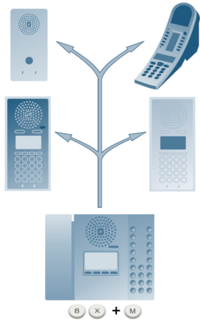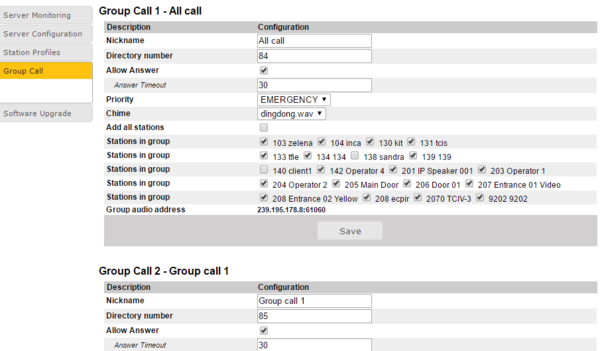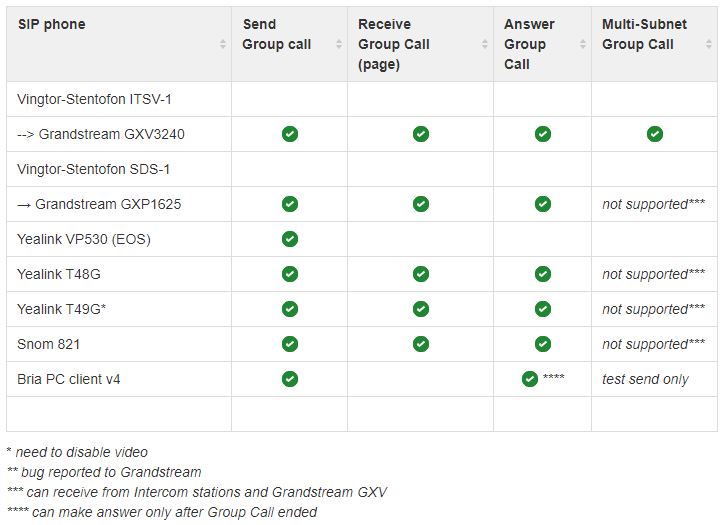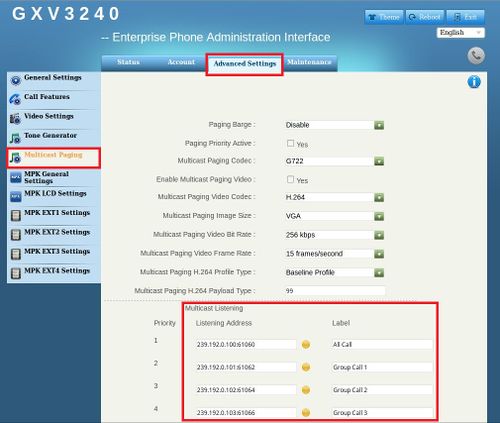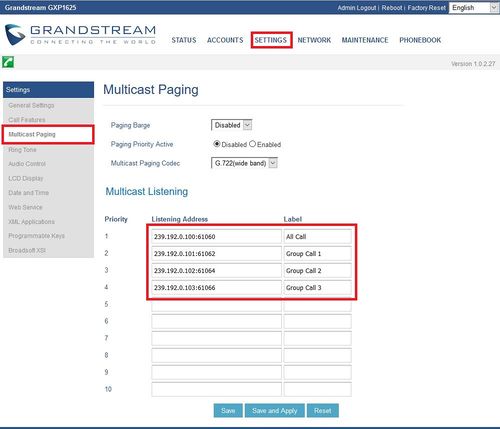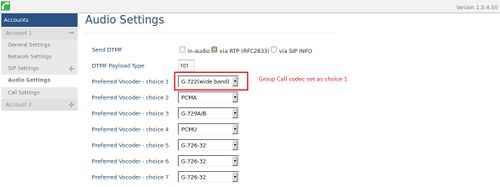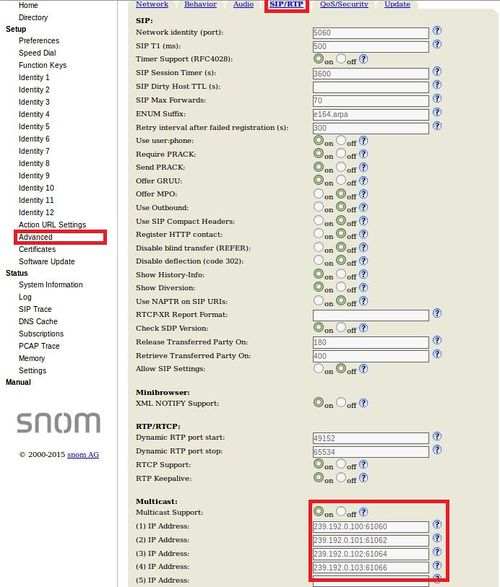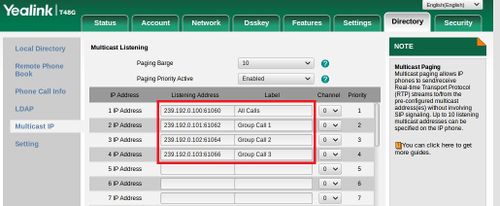Group Call (Pulse)
From Zenitel Wiki
Contents
- 1 Overview
- 2 Default group call settings
- 3 Configuration of group calls
- 4 Allowed Group calls (Station Profiles)
- 5 Answer function (Meet Me)
- 6 Group call Priority
- 7 Group Call support across Subnets
- 8 Pulse Trunk and Remote Group Call
- 9 Group call audio codec
- 10 Group call timeouts
- 11 Software requirements
- 12 Troubleshooting
- 13 Recall
- 14 Group call and 3rd party SIP phones
Overview
The Pulse system supports 4 Group Calls.
A group call is activated by dialing the appropriate code (e.g. 84). A ding-dong signal is heard in all member stations. Press the M-key to speak, and C-key to disconnect. Alternatively, group call can be used in handsfree mode (Turbine only), i.e. no need to press the M-key. Stations without any M-key is using handsfree mode by default. Group call can be answered from any station by dialing the answer code 99.
Group call audio can be sent and received by all Vingtor-Stentofon IP stations and can be sent from most modern SIP IP phones. Group call audio can be received by SIP IP phones that have a support for IP Multicast paging.
Group call will work when Pulse system is installed within multiple inter-routable network subnets.
Default group call settings
The factory default settings for group calls are as follows:
| Nickname (Display text) | Directory number | Priority | Group members | Chime | Answer |
|---|---|---|---|---|---|
| All call | 84 | Emergency | All stations | Ding Dong | Yes |
| Group call 1 | 85 | High | None | Ding Dong | Yes |
| Group call 2 | 86 | Normal | None | Ding Dong | Yes |
| Group call 3 | 87 | Low | None | Ding Dong | Yes |
These settings can be customized under Server Management > Group Call.
Configuration of group calls
The group call properties are configured via the Pulse Server.
- Use a web browser and log into the Pulse Server station (e.g. 169.254.1.99)
- Select Server Management > Group call
- Change the parameters for each group are required:
- Nickname: This is the display text shown in the initiating station when the group call is activated. Can be any text.
- Directory number: The number to dial to activate the group call. If changed, a reboot of the Pulse Server is required for the changes to take effect.
- Allow Answer: Enable Group call answer and configure Answer timeout. Default value is 30 sec timeout to make answer after group call was terminated. Timeout value of 0 means answer is only possible during the group call.
- Priority: A group call with higher priority will override a lower priority group call. See also Group call Priority
- Chime: Enable playing of ding-dong chime when a station receives Group call.
- Stations in group: Select the stations to be group members. You can select all stations in one operation by checking Add all stations box.
- Save: There is a Save button for each group call. Remember to press Save before you make changes to the next group call.
- Group Call audio multicast Address: Multicast IP address and port used to send audio during group all. These information can be used to set up Pulse group call (multicast page) on 3rd party SIP stations.
Allowed Group calls (Station Profiles)
In the Station Profiles you can define which stations are allowed to initiate group calls (Server Management > Station Profiles > Group calls allowed).
Answer function (Meet Me)
If a group call has the Allow Answer option enabled, the group call can be answered from any station by dialing 99 or pressing a preconfigured DAK key. When answering, the group call is automatically canceled, and a point to point conversation is established between the two parties.
A group call can be answered also after the group call has been terminated if the Answer Timeout is set to a value greater than "0". When the timer is set to "0", the group call must be answered before the initiator hangs up.
For 3rd party SIP station to answer group call, it needs to support RFC 3891: The Session Initiation Protocol (SIP) "Replaces" Header. Not all 3rd party SIP stations support this.
Answer during an active call
If a DAK key on a Master Station is configured to dial 99, and the DAK is pressed during an ongoing regular call, the current call will be put on hold.
If a DAK key on a substation is configured to Answer/End Call + Answer Group call, an ongoing regular call will be ended when pressed during an active group call. Pressing the key again will Answer the group call.
Group call Priority
The Pulse system supports 4 group call priorities: LOW, NORMAL, HIGH, and EMERGENCY.
The priority mechanism has the following properties:
- A group call will terminate any ongoing group call with lower priority.
- EMERGENCY priority includes a Volume and handset override feature:
- The volume is turned to maximum level on all receiving stations, and the audio is played on the loudspeaker, even if the handset is off-hook.
- During emergency group call the station will queue all incoming calls. When emergency group call ends, the station will accept calls again.
- If a station sends a busy override to a station listening on emergency group call, then emergency group call will stop at the station listening to the group call.
- If a station is in a regular point-to-point call when receiving a group call:
- LOW / NORMAL priority: The group call audio is not played
- HIGH priority: The group call audio is mixed with the normal call
- EMERGENCY priority: The normal call is muted
- If a station which is not a part of group call initiates a regular point-to-point call towards a station which initiates group call:
- LOW priority: The group call will be dropped, point-to-point call will be established.
- NORMAL/HIGH/EMERGENCY priority: The group call will not be affected, calling station will receive busy signal.
Group Call support across Subnets
Pulse Group call supports network environments with multiple inter-routable segments (or network subnets). Any Vingtor-Stentofon IP station that is part of a Pulse system will be able to make and receive Group call, no matter in which network subnet it is located. There are some prerequisites:
- Network segments need to be inter-routable
- Layer 3 switch or router needs to support IP Multicast routing
Pulse Group call uses multicast IP addresses from IPv4 Organization Local Scope multicast address range - 239.0.0.0/8.
Pulse Trunk and Remote Group Call
When two Pulse Systems are interconnected via Pulse Trunking, a user in one Pulse System one can activate a local group call in the other Pulse system. The Pulse Server in the remote site must be a Turbine device. The "Answer" function (99) will also work.
Example configuration:
Pulse server B with IP 192.16.7.1 has an Emergency Group Call configured with number 120. Pulse server A with IP 192.16.7.10 has Pulse trunk towards server B configured with directory number range 110-120. Dialing Group call 120 from Pulse Site A will be successful.
Note: Global Group Call is not supported. It is not possible to define a group call that spans over several Pulse systems.
Group call audio codec
G.711, G.722, G.729 codecs are supported. Group call shall use codec according to Call settings of the call originator. Audio codec with highest priority will be selected for outgoing Group Call. Stations that receive Group call shall always use codec of the incoming Group Call, even if that means to override station local Call Settings.
Group call timeouts
- Group call timeout if M key not pressed = 60 sec
- Group call timeout = 600 sec Time allowed to hold down the M key before call is hung up. If you release M key, then timer is reset
- Group call timeout in Open mode = 1200 sec Maximum time group call is active when not using PTT (third party group call or DAK group call with open mode)
Software requirements
In general the Group Call feature has always been supported in the Pulse System. The Group Call feature has been enhanced in the Turbine ver. 4.7 and in INCA ver. 2.7.
Turbine ver. 4.7 or INCA ver. 2.7 or newer is required on the Pulse Server for the following group call related features:
- Answer Group Call feature
- Handsfree group call
- Enable/Disable chime
- Recall from VS-Client
- Group call across subnets
- Group call to/from 3rd party SIP phones
Backwards compatibility support
Both Pulse clients (stations) and the Pulse server need to be upgraded to firmware version 4.7 for Group call to be able to work on all IP stations. Meaning, a combination with 3.0.x or 4.2 firmware with 4.7+ firmware will not work in some scenarios.
Troubleshooting
If you experience any problems with the group call feature, please consult the table below:
| Problem | Solution |
|---|---|
| When making a group call, the ding-dong is heard in the stations, but no audio. | The problem is that the multicast audio does not reach the stations, which may be because of two things:
|
| The group call is terminated after 60 seconds, even if the M-key is still pressed. | Make sure that the flag Send DTMF */# with M key is enabled in Call Settings. If this flag is disabled, the Pulse Server doesn't get any inforamtion from the station that M-key is pressed, hence it will use the default timeout of 60 seconds. |
| Third party SIP phones cannot initiate group calls. Ding-dong is transmitted, but there will be no audio. | Reason being that in group call the calling station distributes audio using multicast, which is not supported by 3rd party SIP phones. |
| Group call audio is not played on IP Stations in different network segment | Layer 3 switch or router needs to support IP Multicast routing. |
| 3rd party SIP phone does not receive Group call. | SIP phone needs to have a support for what is known as "IP Multicast paging" which enables phone to listen to a specific multicast IP address. It will play audio in case of incoming Group call on that specific multicast IP address. |
| 3rd party SIP phone Group Call audio is not played on stations in different network segment. | For 3rd party SIP phone to support Pulse Group call over multiple network segments, it needs to be able to send multicast IP packets with TTL value higher than 1, e.g. TTL=32. |
Recall
The Recall function let you record a voice message, listen to the message, and then dispatch the recorded message in a Group Call. The Recall function is supported from VS-Client (a Softclient on a Windows PC) version 1.3.3.1 or newer. Intercom stations do not support Recall.
Group call and 3rd party SIP phones
All modern SIP IP phones can make a Pulse Group Call and have a support for Group call Answer.
Pulse Group call can be received by SIP IP phones that have a support for what is known as "IP Multicast paging". Multicast paging is an approach that enables SIP phones to listen to a page from a common multicast IP address. Group Call audio multicast address from Pulse Group call settings is used to register a SIP phone to listen for multicast page. In multicast page call, one way audio will be setup from sender to all listeners.
Below shows the configuration of some SIP phone models.
Grandstream GXV3240
Grandstream GXP1625
Snom
Yealink T48

